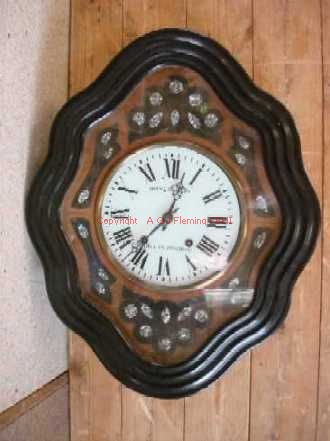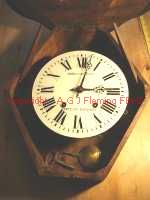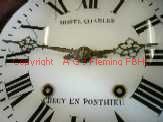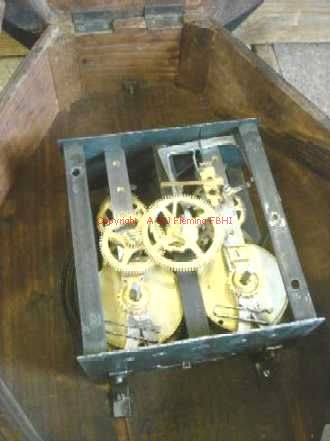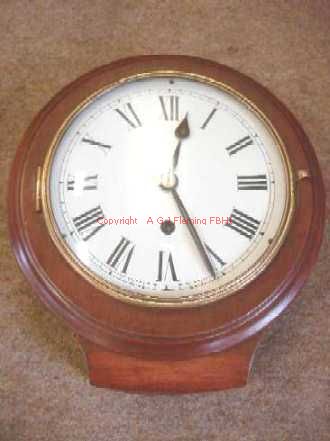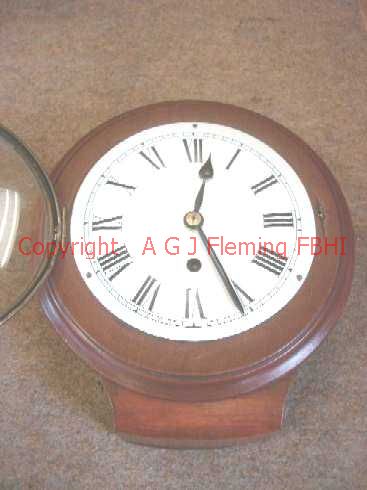Wall Clocks For Sale
If you're interested in buying any of the clocks featured here, please contact me.
While I am happy to post clocks to you, I personally believe it is always better to see them 'in the flesh' before buying and then you can take them with you, avoiding the potential for damage!
If you do not see what you want here please ask, as I have a selection of clocks still awaiting restoration - one of which might be just what you are looking for!
I do not take credit/debit card payments, but if you want to buy an item please phone me on 01451 810187 and I will give you my bank details for an internet transfer
All clocks I sell have been fully overhauled by me personally and are fully guaranteed for one year.
Tableau Comtoise clock
This is a French wall clock which shares a peculiarity with French longcase clocks in that it strikes the hours twice - once at the hour and again a couple of minutes later. In fact the movements are almost identical - with only the gear ratios (to allow for a shorter pendulum) and the motive power being different.
It is a highly decorative clock, with mother-to-pearl floral inlay in dark wood panels in the pale wood ground, all covered by glazing inside the ebonised outer bezel.
This makes the front quite heavy, which normally presents a problem for the hinges at the top of the front as there is generally only one prop to hold it open for winding - resulting in quite a twist. However this clock has one on each side so the hinges are not put under strain.
The dial on this clock is the better quality glass one, painted on the reverse and held to a metal backing plate by the hole-grommets.
Maximum dimensions: 620mm high by 490mm wide by 130mm deep, dial
is 230 mm diameter
Stock No 37
£790
Drop-dial clock
Here I am selling a small drop-dial clock with a German movement of good quality but unidentified maker.
The 'drop' is hinged on the right side with a latch on the left, swinging down in front of the back board (which continues to level with the bottom of the drop) to reveal the pendulum.
It has a nice clear dial, with good colour to the wood.
A very attractive little clock...
Maximum dimensions: wooden bezel is 240mm diameter, the 'drop' below it is 23mm,it is 100mm deep, and the dial is 170mm diameter.
Stock No 7
£370
Small Fusee Dial Clock by French & Son of London
This is a particularly nice example of a small dial clock, with a slightly convex enamel dial signed French & Son / London.
It has a late model of fusee movement, with plain pillars screwed at both ends. The back plate is stamped 6472 / LONDON just to the right of the bottom left pillar.
The movement is secured in the case by two steel straps running vertically behind the dial, not to the dial plate itself so that the enamel will not get damaged.
There is a slight chip to the bevelled edge of the 4mm-thick front glass (at about 9 minutes past), and there has been some repair-work to the case - but what would you expect?
As with all my clocks, it is fully overhauled and guaranteed
DIMENSIONS - case diameter: 11 1/4” Case depth: 5” (to the front of the glass), dial plate diameter: 7 3/4” chapter ring: 6 5/8”
Stock No 39
£790
Ship's Radio Room Clock
This clock has a rather unusual dial. It is from a ship's radio room. The sectors cross-hatched in red and green are there to remind the operators to keep radio silence and listen out for distress signals on 500kHz and 2182kHz respectively. This was a system introduced after the sinking of the Titanic, and initially only had the 500kHz frequency, with the 2182kHz frequency being added later. I suspect this clock may not have been the main radio-room one, as that sould have had a seconds hand, which has never been the case with this model. It is made by S Marti of France, and was made some time after 1931. (The 500kHz frequency is no longer monitored)
The visible part of the dial is 3.5" diameter, with the inside of the minute tramline at 3.1".
Maximum dimensions: Diameter of the back flange 4.9", Aproximately 1.7" deep
Stock No 22
£475
Wooden clock with verge escapement
This is a bit of fun really.
It is a reproduction of the sort of clock that was produced many years ago - though they would mostly have been made of metal.
The rate at which it runs is controlled by the weights on the oscillating arm (or 'foliot') at the top - the further out they are the slower it runs. It ticks about 40 times a minute - very slowly! Even so it needs a 6'6" drop for the line & weight in order to run for a full 24 hours. This means the dial centre needs to be at 7' above the floor, with a ceiling height of not less than 7'9" (2.36m). It is probably designed to be wound twice a day, with the dial at face height.
The back of the back bard is stamped HELO / No Jewels / West Germany / unadjusted - which I think must be a bit of bureaucracy gone mad!
Maximum dimensions: Dial diameter ~ 175mm, back plate 410mm
Stock No 113
£275
"Sestrel" Bulkhead Clock
Here we have a typical brass-cased bulkhead clock with a platform escapement.
It has an Elliott Clocks movement, serial number 12835, which I think means it was made in 1935
Because Elliotts put low quality 7 jewel platform escapements on their clocks I have replaced the platform with a high quality 11 jewel one, and it runs beautifully.
There is some minor scratching to the dial around the winding hole & out to the VII, and the lacquer on the body of the case is showing some signs of it's age, but otherwise it is in good condition, undented, and with no chips to the glass, and with a positive"snap" when you close the front bezel.
Maximum dimensions: Rear Flange 146mm (5.75") diameter, dial 103mm (4") diameter, depth 67.5mm (2.65")
Stock No 117
£275
Octagonal Wall Clock
This beautiful clock has a wooden case with a mahogany veneer, inlaid with brass, on a pine carcase.
The front bezel does open, so you could adjust the time shown from the front, but since you have to wind it from the back and there is a hand-set knob there as well, I would recommend adjusting the time from the back.
It has a convex brass dial with engine-turned centre and a chapter ring of minute lines (replaced with slim triangles at the 1/4-hrs and bolder lines at other hours) and Arabic hour numbers.
The movement is a standard French drum movement with a lever platform escapement, unsigned, stamped FRANCE just to the left of the ratchet click, and with the normal arrow for the hand-set direction.
Maximum dimensions: Dial diameter 80mm, height 210mm, width 240mm (including the lion's heads), and depth 90mm
Stock No 93
£275
Modern Zaanse Dutch Clock
This is a modern 'Zaanse' style clock with standard English/European striking, not Dutch striking. The dial has a chapter ring with a colonnaded tramline for the minutes, Roman hour numbers and an inner (round) tramline also marking in minutes (not in quarter-hours as one might expect).
For it's full 29.5hr run-time the dial centre needs to be 89" (~2.25m) above ground level, with the ceiling a further 9" (~ 23cm) above this... However, it only needs about a 6" drop for the line & weight in order to run for 24 hours. This means the dial centre needs to be at about 6'3" above the floor, with a ceiling height of not less than 7' (2.14m); so if you are prepared to wind it at almost exactly the same time every day the dial can be just above face level, if not you will definitely need to look up at it, or wind it twice a day!
Maximum dimensions: Dial diameter ~ 85mm, back board of clock 455mm high x 190mm wide, max depth 135mm
Stock No 72
£300
English Dial Clock with Ebonised case
This is a typical English Timepiece Dial Clock in an ebonised case. These clocks are also often referred to as school clocks, office clocks, & railway clocks, but this one has never had anything to do with a railway! The dial is 12" diameter, with a chapter ring of 11" outside diameter. The wooden (ebonised) bezel is approximately 15¾" diameter
It has a typical 8-day fusee movement of good Victorian quality, which will outlive the grand-children of anyone alive today (provided it is suitably maintained).
The case has 2 latched side doors and a locking bottom door, and this one has the bezel retained on the box by three wooden pegs, rather than the more common four pegs. It comes with (I believe) the original fusee-style winding key which still has some of the black paint it was covered in to make it match the clock. Despite the use it will have had it is still a good fit on the winding square.
Maximum dimensions: Outside diameter ~ 15¾", depth 6"
Stock No 28
£600
Morbier or Comtoise French Long pendulum Bracket Clock
This is a typical Morbier clock designed to sit on a bracket on the wall. They can also be slotted into a wooden case, but this one is 'uncased'. These clocks are also often referred to as Comtoise clocks, a name taken from the district of Franche-Comté where the town of Morbier is.
The dial is 210mm diameter, with a chapter ring of 200mm outside diameter. The movement is entirely enclosed by metal top, bottom, dial & side doors and a wooden back on which the gong is mounted.
It has a typical later Morbier movement with an anchor escapement.
As with all these clocks the movement is back-to-front compared to an English movement, with the pendulum at the front, the strike train on the right and the time train on the left. Another peculiarity is that they strike once at the half hour and the relevant number at the hour, but this is repeated about 3 minutes later - to give you a second chance to count the blows! The hour strike can also be repeated at will by pulling a repeat cord.
It comes complete with a wooden bracket with gold-painted metal brackets for the movement to sit on and of course the typical French longcase pendulum with a rod in 3 pieces loosely riveted together...
Maximum dimensions of movement box: Height 265mm, Width 260mm depth 190mm Minimum height of bottom of movement box above the floor for an 8-day run 1.82m or just under 6' or 5'5" for a bare 7 days
Stock No 86
£650

designed by WebMagic


